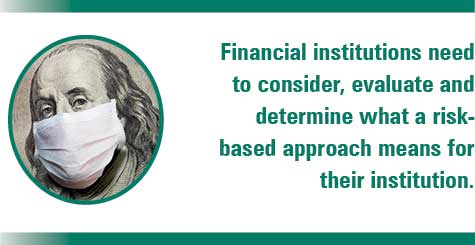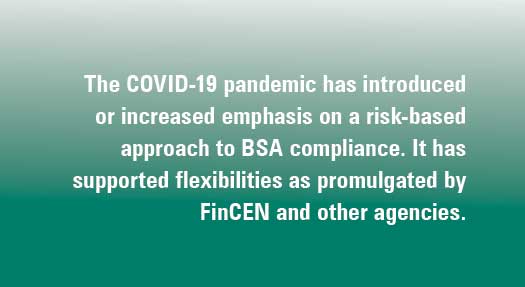By Elizabeth K. Madlem, Compliance Alliance
The formal study of risk management has been around since World War II and involves learning how to identify, assess and manage financial risks for an organization. It has long been associated with market insurance, protections from accidents and the use of derivatives. It evolved into contingency planning, analyzing various risk prevention activities and portfolio management. Operational and liquidity risks emerged as a formalized concept in the 1990s as financial institutions intensified their market risk and credit risk management activities. Risk management has become a corporate affair — it is a major player in an institution’s management and monitoring policy decisions. The concept of risk began to cover pure risk management, technological risk management models and operational risk. And as the identification of new risks emerged, so did an expanded concept of operational risk.
Fraud risk is a form of operational risk. It is the risk to current or projected financial conditions and resiliency arising from inadequate or failed internal processes or systems, human error or misconduct, or adverse external events. Fraud historically has been known to increase during disaster-related events. The unprecedented COVID-19 pandemic is no exception to this increase. Fraud can be characterized as an international act, a misstatement or omission to deceive others with the sole purpose of a victim suffering a loss or a perpetrator achieving gains. It can be internal or external, but the key takeaway with fraud is that financial institutions subject to the Bank Secrecy Act are mandated to keep up an anti-money laundering compliance program and process. Meeting BSA and AML obligations during a pandemic has proven challenging. It has forced financial institutions to adopt a new “business-as-usual process” that magnified challenges for financial crime management programs within institutions of all asset sizes.
Financial institutions, despite any differences in scale, are all facing work from home shifts, evolving customer behaviors and expectations, along with a rise in pandemic-related fraud patterns. The combination of financial and health risks opens vulnerabilities and creates more opportunities for fraudsters. The Agencies recognize that the current environment is (1) unprecedented and (2) requires flexibilities. Back on March 16, 2020, FinCEN released a state to financial institutions regarding the impact of the COVID-19 pandemic. It encouraged financial institutions to communicate their concerns related to the pandemic and, above all things, to remain alert to illicit financial activity. It encouraged financial institutions that had concerns over potential delays in filing any required BSA reports (CTRs and SARs) to contact FinCEN and their functional regulator as soon as practicable.
Second, FinCEN outlined the emerging trends connected with COVID-19: impostor scams, investment scams, product scams and insider trading. Financial institutions are reminded to review FinCEN’s 2017 advisory FIN-2017-A007 for descriptions of other relevant typologies, which included benefits fraud, charities fraud and cyber-related fraud. Entering “COVID19” in Field 2 of the SAR-template when reporting suspicious transactions linked to COVID-19 was highly encouraged. But key pressure points continued to emerge in the new environment for financial institutions. Not only were financial institutions required to identify fraudulent and potentially suspicious activity outside of normal trends, but they also had to detect disaster-related fraud, increase their protection of elderly customers and report on COVID-19 trends and losses. This is not to say financial institutions have not risen to the challenges.

FinCEN’s April 3, 2020, notice encouraged financial institutions to “consider, evaluate, and, where appropriate, responsibly implement innovative approaches to meet their BSA/anti-money laundering compliance obligations.” Institutions have considered the health and safety of their employees and customers. They have maintained the financial system’s stability, managing and mitigating the risks of money laundering and fraud losses. But what considerations should financial institutions continue to focus on as they navigate BSA/AML compliance?
- Contingency Plans — Financial institutions need to be anticipating best and worse case scenarios. How will the financial institution reestablish its BSA/AML program and obligations after pivoting from remote work and returning to normal? If the pandemic continues, what longer-term necessities and measures need to be taken to maintain or increase the financial institution’s BSA/AML practices?
- Customer Due Diligence — COVID-19 has transitioned rapidly into more than a disease. It has also impacted online banking. Customers are expecting banks to go even more digital via their online channels. This has not been without changes in expected activity for both individuals and businesses. Has an institution increased its daily transaction limits to meet increased demands for additional cash? Has cash hoarding strained a bank’s CTR filings? Did the organization experience an increase in false positives for fraud due to changing customer behaviors? Financial institutions need to continually evaluate their programs to grab control of the challenges and added workload to their BSA/AML staff.
- Risk Assessments — No longer something for larger or more complex financial organizational structures, the need for risk assessments has increased. Customers have changed the scale of their operations. Under the CARES Act, programs like the Paycheck Protection Program have flooded lending and operations divisions within the bank, which inhibits adequate oversight. Risk assessments need to continue to be reassessed on both a customer base and organizational level to reconsider customer relationships’ nature and purpose, continue that development of customer risk profiles, and reassess bank operational systems and controls. This was reemphasized in the update to the FFIEC BSA/AML Examination Manual released April 15th.
- Coordination and Communication — Identifying logistical challenges is one aspect; effectively communicating them to bank staff is another. Internal communication is essential. Impactful and cohesive running of compliance teams will aid financial institutions in minimizing the challenges of administering an effective BSA/AML compliance program during a pandemic. A risk-based approach with diligent adherence to a bank’s BSA obligations will define compliance problem areas and assist financial institutions in mitigating their risks.
- Technology — FinCEN’s April guidance encouraged financial institutions to be innovative through the deployment of “novel technologies.” While this encouragement has many possibilities, it does create challenges for financial institutions. Banks still must maintain prudent evaluations whenever implementing innovative approaches to current BSA/AML processes. Financial institutions need to maintain robust oversight of their vendor management relationships with third-party providers, especially related to BSA/AML program implementation. Safety, soundness and consumer protection are heavily impacted by technology, increasing a bank (and regulator’s) focus on monitoring.

The COVID-19 pandemic has introduced or increased emphasis on a risk-based approach to BSA compliance. It has supported flexibilities as promulgated by FinCEN and other agencies. While regulators have highlighted the difficulties, realized or otherwise, little reassurance or solutions have been offered by financial institutions. For this reason, financial institutions need to consider, evaluate and determine what a risk-based approach means for their institution. Criminals are luring targeted, vulnerable individuals and companies with an even stronger virtual presence. These attempts aim to undermine the bank’s due diligence and “know your customer” processes within a remote environment. It is imperative that financial institutions review FinCEN and other Agencies’ releases on advisories highlighting common typologies used in fraud, theft and money laundering activities related to the pandemic. The significant increase in online and digital transactions coupled with cyberattacks and related fraud will continue to impact remote platforms and processes. Understanding the new and expanding definition of fraud risk will force financial institutions to remain diligent with BSA/AML controls and procedures related to the pandemic.
Elizabeth K. Madlem, is the Vice President of Compliance Operations and Deputy General Counsel at Compliance Alliance. In the past, she served as both the Operations Compliance Manager and Enterprise Risk Manager for Washington Federal Bank, a $16 billion dollar organization headquartered in Seattle, Washington.
She has industry expertise and real-world solutions surrounding bank-enterprise initiatives and knowledge of contract law and bank regulatory compliance. An attorney since 2010, Elizabeth was a Summa Cum Laude, Phi Beta Kappa, Delta Epsilon Sigma graduate of Saint Michael’s College in Burlington, Vermont, and a Juris Doctor from Valparaiso University School of Law in Indiana.
As the Vice President of Compliance Operations, Elizabeth will be overseeing C/A’s day-to-day operations of the hotline, as well as leading our education initiatives. Elizabeth plays an important part in all operational areas of C/A.
This story appears in Issue 4 2020 of The Arizona Banker Magazine.










